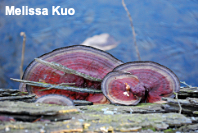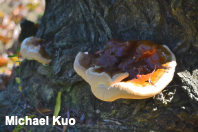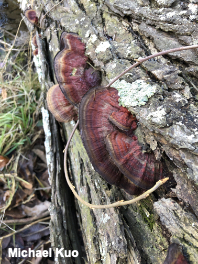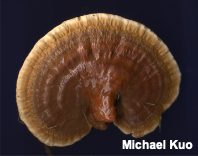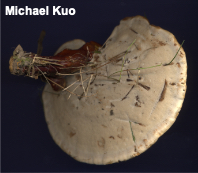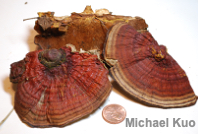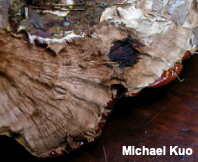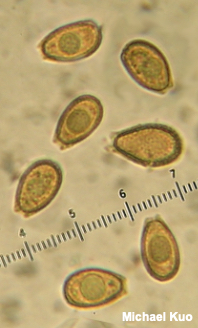| Major Groups > Polypores > Ganoderma > Ganoderma sessile |

|
[ Basidiomycota > Polyporales > Polyporaceae > Ganoderma . . . ] Ganoderma sessile by Michael Kuo, 28 May 2024 Widely distributed and fairly common east of the Rocky Mountains, Ganoderma sessile is a beautiful polypore found on the wood of hardwoods. Its deep red cap has a lacquered-looking upper surface and, like other species of Ganoderma its pore surface bruises brown and its spores have double walls with a chambered appearance. Ganoderma sessile was for many years folded into "Ganoderma lucidum" in North America, including at this website—but recent research (Loyd and collaborators, 2017, 2018) indicates that Ganoderma lucidum is a non-native species found only in two North American locations (in Utah and northern California) where it may have been accidentally introduced by mushroom cultivators. Ganoderma sessile can be confused with several similar North American species—especially Ganoderma curtisii. Ostensibly, the latter species has a fairly well-developed stem, while Ganoderma sessile does not ("sessile," by the way, is Mycologese for "without a stem"). However, both species are fully capable of breaking the stem rules, and do so often. More reliable characters separating the two species include spore size and the presence or absence of "melanoid bands" and "concentric growth zones" (see discussion) in the flesh of the mushrooms; Ganoderma sessile has large spores and features concentric growth zones but not melanoid bands, while Ganoderma curtisii has smaller spores and features melanoid bands but not concentric growth zones. Thanks to Sister Mary Philomena, O. P., for documenting, collecting, and preserving Ganoderma sessile for study; her collection is deposited in The Herbarium of Michael Kuo. Description: Ecology: Saprobic and sometimes parasitic; growing alone or in groups on decaying hardwood logs and stumps, or from the wounds of injured, living trees (including the ancient and probably done-for eastern redbud in my back yard); causing a white rot; annual; spring through fall; originally described from New York (Murrill 1902); widely distributed east of the Rocky Mountains. The illustrated and described collections are from Illinois, North Carolina, Ohio, and Texas. Cap: 8–30 cm across; 4–20 cm deep; more or less semicircular in outline, or irregularly kidney-shaped; planoconvex; surface with a lacquered-looking outer crust; brownish red or reddish brown overall, with or without zones of various colors (paler red, tan, orangish brown, yellowish brown, or grayish); in old age becoming dark brown overall; bald; becoming radially wrinkled; often lumpy near the point of attachment to the wood. Pore Surface: Whitish to pale brownish when young, becoming medium to dark brown with age; bruising darker brown; with 2–4 circular pores per mm; tubes to 7 mm deep. Stem: Usually absent but sometimes present; when present usually lateral and stubby but sometimes well-developed, up to 5 x 2 cm; lacquered, brownish red to reddish brown. Flesh: Tough but not woody; pale tan to pale brown; without melanoid bands but with concentric growth zones (see discussion). Odor and Taste: Not distinctive. Chemical Reactions: KOH instantly black on flesh and cap surface. Spore Print: Reddish brown. Microscopic Features: Spores 8.5–14 x 5.5–8 µm including the hyaline vesicular appendix; more or less ellipsoid, with a truncated end; appearing double-walled, with a series of "pillars" between the walls; finely stippled; inamyloid; brown in KOH. Cystidia and setae not found. Hyphal system trimitic. Clamp connections present only on generative hyphae. REFERENCES: W. A. Murrill, 1902. (Loyd et al., 2017; Loyd et al., 2018.) Herb. Kuo 09040301, 08231301, 12241801, 08101904, 09292202, 05222401. This site contains no information about the edibility or toxicity of mushrooms. |
© MushroomExpert.Com |
|
Cite this page as: Kuo, M. (2024, May). Ganoderma sessile. Retrieved from the MushroomExpert.Com Web site: http://www.mushroomexpert.com/ganoderma_sessile.html |
